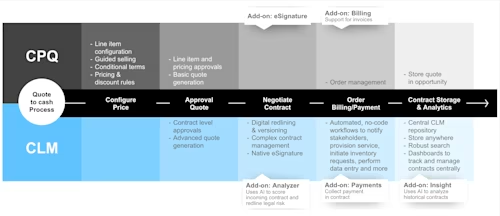
6 Reasons CLM and CPQ Are Better Together for Quote-to-Cash
Let's examine some specific challenges stemming from the contract gap that contract lifecycle management (CLM) and CPQ solutions can, together, solve.
Table of contents

Some sales cycles are fast and simple. However, many organizations have complicated offerings that involve customization, a subscription revenue model, bundling, partner products/services, complex pricing and/or a high volume of individual quotes. Configure-Price-Quote (CPQ) solutions play an important role in streamlining the quote-to-cash process in these situations. CPQ helps sales teams sell the right combination of products, manage pricing and discounting and automate sending quotes for approvals.
Generating a quote is not the end of the sales process though. One area that many sales teams struggle with is the contract gap, which involves the manual execution of a contract spanning from when the document is generated through to when the final signed version is stored in the opportunity record and services are rendered. There are many manual and error prone steps like negotiation, redlining, approvals and operational workflows. Let’s look at some of the specific challenges stemming from the contract gap that contract lifecycle management (CLM) and CPQ solutions can, together, solve.
Generating custom quotes and supporting documents
CPQ solutions enable sellers to create complex quotes to sell the right combination of products at the right price. However, some quotes need extra customization like reformatting tables or changing currency to be digestible by prospective buyers. This isn’t possible in CPQ. In addition, there are often other documents like a broader sales contract or a statement of work that need to be generated and sent along with any quote.
By integrating CLM with CPQ, businesses can generate more complex and customized quotes that are built in CPQ as well as automate other contract generation with a click out of their CRM opportunity. With a more streamlined contract generation process, sellers can present clean quotes and guide deals through to signing with greater accuracy and efficiency.
Negotiating quotes
When quotes and accompanying MSAs are sent out by the seller from a CPQ tool, they are very rarely final. Upon receipt by the prospect, they usually require some level of back-and-forth discussion, redlining and negotiation. When done by email and tracking changes in Word or PDF, the process drags out and is highly error prone. According to the Docusign State of Contract Management report, negotiation takes 25 days on average.
With a CLM, sellers can digitally collaborate and keep a centralized record of who changed what, allowing for version control and increased accuracy. This makes life easier on the legal team, creates a better customer experience and helps move deals along much more quickly.
Reviewing and approving documents
Once quotes have been generated and negotiated, there are typically a number of approvals that are required. CPQ systems do a great job of automating pricing and other approvals associated with building a quote, but CLM supports full document approvals and workflows.
For example, once a quote is finalized, the document along with a customized MSA might need to be approved by a sales VP and the CFO among others. Additional internal team members and customer contacts may need to be simply notified. With CLM, these document workflows can be automated with guardrails in place based on rules so that approvals are streamlined end-to-end.
Signing documents
Once agreed upon and approved, quickly obtaining a signature on a quote is needed to close the deal. Electronic signature is natively part of CLM, but can also be integrated standalone into a CPQ system. Using eSignature provides the seller with a way to obtain fast, easy, reliable signatures.
Utilizing a centralized document repository
Documents are challenging to manage because they are unstructured data, which is not what systems like CRM and CPQ are built for. Without a central location for documents, many basic steps become difficult: search, access, analysis and even simply finding a document. A contract lifecycle management solution provides a central repository for document storage and automatically saves contracts of all types there as well as any other locations a copy should be. This allows companies to easily find, analyze and share out documents whenever the need arises, leading to a much more fluid experience.
Billing and invoicing
Completing the full quote to cash process includes how your customers are actually billed. Generating high volumes of invoices can be tedious, error-prone and time consuming when done manually. In addition, even though an invoice can be seen as very transactional, it is still a reflection of your company. Batch invoice generation can be accomplished using a CLM solution or billing add-on to CPQ. Automating the generation and sending of invoices allows businesses to distribute invoices in a timely manner, resulting in faster payments and a more seamless process. All the while, you’re ensuring that the invoices that you are sending out are still on brand, and a professional representation of your company.
Closing the contract gap with CLM
In order to close the sell-side contract gap and amplify the benefits of CPQ software integrated with a CRM solution, it’s critical to leverage modern systems of agreement using contract lifecycle management (CLM) software. In the diagram below, you can see how CPQ and CLM complement each other through the quote-to-cash process.
Better together: Docusign CLM with Salesforce CPQ automates the most complex quote-to-cash processes

Docusign’s Agreement Cloud is the leading contracting platform that closes the quote-to-cash contract gap, automating manual tasks like complex document generation, digitizing negotiation, orchestrating business workflows and minimizing unnecessary risk. The Agreement Cloud integrates into CRM and CPQ systems and is made up of several core capabilities, including electronic signature, contract lifecycle management and contract analytics.
Learn more about the Docusign Agreement Cloud for Sales and Docusign CLM.
Related posts
Docusign IAM is the agreement platform your business needs


